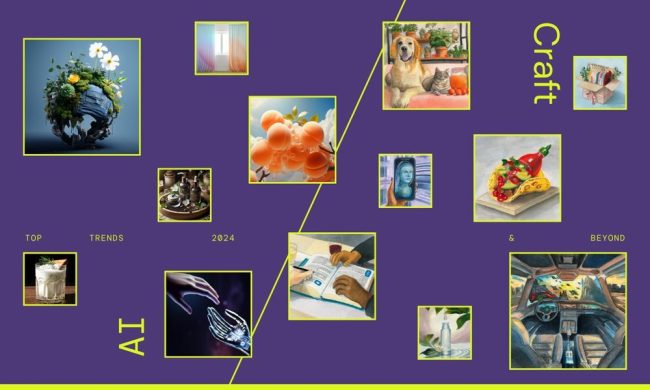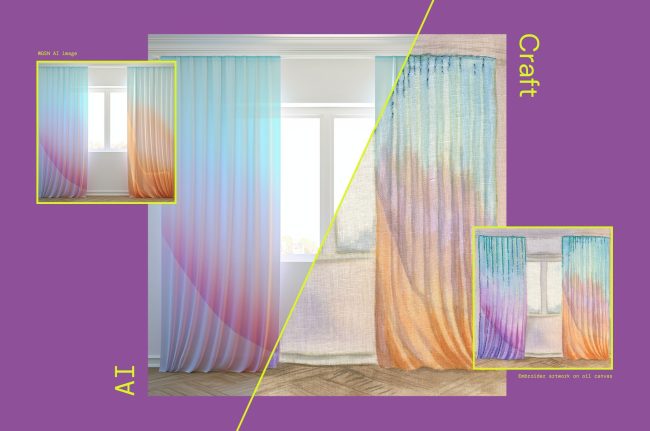WGSN, the consumer trend forecasting company, has recently announced 13 trends that will define 2024 and beyond, covering fashion, interiors, beauty, tech and food and drink.

WGSN
AI Collaboration in Design
Design professionals are increasingly partnering with generative AI, boosting both their creative exploration and efficiency.
The swift advancement of generative AI technologies is reshaping the creation and development of digital products, simultaneously making it easier for individuals to produce content by reducing entry barriers. Studies show that incorporating generative AI tools into designers’ workflows can heighten their efficiency.
Thanks to no-code/low-code AI solutions, designers can now dedicate more of their efforts to the creative aspects of their roles, rather than the technical coding elements, as AI improves process management. Hence, organizations will have to reconsider their procedures and policies to accommodate a new breed of professionals — those who are adept at using these tools and inclined towards innovative approaches.
AI Assistants in Consumer Tasks
 AI technologies are aiding consumers with tasks they prefer to avoid.
AI technologies are aiding consumers with tasks they prefer to avoid.
For instance, realtors have started enabling users to visualize and find their dream homes through search engines. Users articulate their ideal home characteristics, and are presented with a corresponding image and available listings that visually match the description.
Similarly, in the travel industry, new trip planning tools are introduced to assist users in holiday planning. AI is also being used in personal shopping and life coaching. Additionally, there’s a growing trend of AI assistance in workplaces for routine tasks. Companies have used AI for content creation and even integration of AI across their business operations.
Thrift-Adult Trend
Consumers are adopting a novel approach to office wear, combining thrifted attire with crafted customization.
This trend transforms traditional office dressing, merging personal style with professional identity for a unique, playful twist on workwear. The key to this look is blending thrifted items with new purchases through eclectic DIY styling and craft-led customization. Thrifters creatively use their new purchases to achieve this fashion-forward vision, ensuring each item is versatile enough for both professional meetings and social gatherings.
This style embodies nonconformity and inclusivity, typical of Gen Z, featuring gender-inclusive elements. The foundation of thrift finds includes blazers, pinstripes, ties, and ’80s shoulder pads, while modern, high-fashion tailoring brings a contemporary edge to city dressing for a new generation.
Apricot Crush Color
 A warm, restorative color is appealing to those seeking mental and physical nourishment.
A warm, restorative color is appealing to those seeking mental and physical nourishment.
In line with the growing emphasis on holistic lifestyles, Apricot Crush resonates with consumers dealing with a range of emotions and concerns about the future. It is a vibrant, vitamin-inspired shade that promotes a comprehensive approach to health and wellbeing. It evokes the antioxidant benefits of apricots and oranges, as well as the beauty of nature.
As a prominent and solid shade in activewear, especially for recovery and warm-down garments, Apricot Crush will continue to be significant as a psychological mood enhancer, fostering hope and positivity during uncertain times.
Auto-tainment Concept
In the near future, transportation time will become leisure time, with cars serving as spaces for work, rest, and entertainment.
Features like retractable desks, adaptable in-car layouts with lounge-like seating, and high-quality materials will become more common, alongside sensory exploration to relax, restore, and enhance immersive experiences in gaming and entertainment. Advanced technology and smart assistants will transform cars into mobile living spaces.
Plant Milking in Sustainable Beauty
 A revolutionary method takes off in sustainable beauty involving alternative ingredient sourcing. Plant milking, an environmentally friendly and non-destructive technique, uses aeroponic cultivation and extracts active ingredients from plant roots.
A revolutionary method takes off in sustainable beauty involving alternative ingredient sourcing. Plant milking, an environmentally friendly and non-destructive technique, uses aeroponic cultivation and extracts active ingredients from plant roots.
This method maximizes yield while minimizing land and water use. Plants can be ‘milked’ multiple times a year, and the process is fully traceable, allowing beauty consumers to track their product’s journey from root to routine.
Third-Culture Cuisine
Diverse culinary heritages are blended with new hybrid cuisines. ‘Third-culture cuisine’ is the food of people raised outside of their parents’ cultures. Some early examples include Japanese-South African food or Japanese-Italian cocktails.
Globalization is fostering a generation of third-culture chefs, whose cuisine combines their inherited culinary traditions with the food cultures of their upbringing or current environment. By 2024, these unique cuisines will be recognized as distinct genres, inspiring new packaged goods and dishes.
Social Learning Spaces
New educational spaces blend collective experiences with learning opportunities. They may replace traditional campuses or offices in an increasingly remote world, focusing on individual passions and curiosities. Some emphasize accessibility and learning for pleasure, while others provide a university-like setting for postgraduates, fostering study groups and discussion classes.
In Asian cities, the expansion of bookstore-cafes represents a growing interest in social learning experiences, with studies indicating their importance as recreational settings for Chinese youth.
Multi-Species Home Concept
Consumers are adapting living spaces to meet the needs of various species, including pets and plants.
Homes accommodating all species, from household plants to pets, represent an emerging nontraditional family concept. Multi-species homes are relevant across generations, with Boomers and Gen Xers adopting pets and Millennials and Gen Z viewing their pets and plants as family members.
Also, pet-centric interiors are becoming more established, with features like dog dining rooms, catios, and pet showers designed for both aesthetics and practicality.
Backyard Beauty Trend
Soil preservation is becoming a key element in sustainable beauty.
Sustainable beauty brands are emphasizing soil care, akin to skin care, with circular systems and regenerative farming. Soil and insects are becoming important sources of beauty ingredients, offering skin-beneficial actives. Packaging will also evolve, with compostable materials that release beneficial elements like nitrogen and potassium.
Curtains as a Home Trend
 Curtains are getting renewed interest for both aesthetic and functional purposes. Once seen as old-fashioned, they are becoming more and more popular for their insulating properties and ability to enhance aesthetics and energy efficiency. Innovative materials protect against extreme temperatures and can even purify the air. Curtains also help define spaces, capturing natural daylight and extending it, with some designs even glowing at night.
Curtains are getting renewed interest for both aesthetic and functional purposes. Once seen as old-fashioned, they are becoming more and more popular for their insulating properties and ability to enhance aesthetics and energy efficiency. Innovative materials protect against extreme temperatures and can even purify the air. Curtains also help define spaces, capturing natural daylight and extending it, with some designs even glowing at night.
Biodegradable Denim
With over 2 billion pairs of jeans produced globally each year, innovative solutions are needed to manage apparel waste. Developing new fibers will reduce jeans waste.
Retailers introduce innovations such as jeans with a coating that allows the garment to biodegrade almost entirely in nature within less than a year. Another example is a biodegradable stretch denim using plant-based technology or completely compostable jeans.
Meals as Drinks
There’s a noticeable shift towards umami-flavored beverages over sweet, sugary cocktails. Mixologists are experimenting with flavors like bitterness, spice, and salinity, creating drinks with umami-rich profiles based on classic meal flavors. Examples include new cocktail names like Double Chicken Please, Cold Pizza, Nasi Goreng, and Thai Beef Salad.
Source: https://www.wgsn.com/insight/p/article/658fc24a8bd05fada7578390










